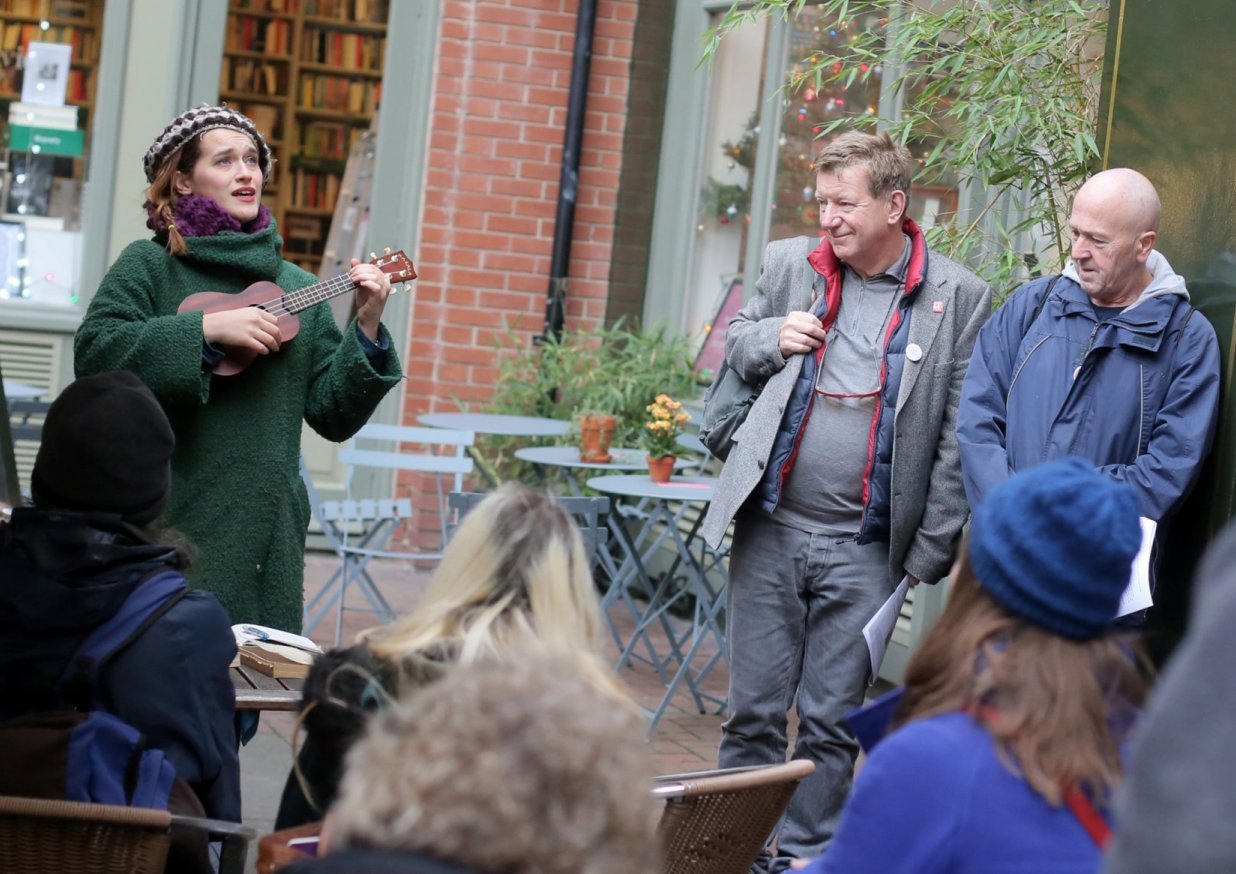
Photo: Lloyd Sturdy
Tensions between the everyday and the exceptional
How can we make the arts an everyday experience for everyone? Michael Eades explains why he believes in the power of grassroots arts.
What is the ‘everyday’? It’s a question that is fundamental to thinking about how we encourage ‘everyday participation’. But at the same time it’s a surprisingly tricky one to nail down.
Philosophers have argued about this for decades, if not centuries. One formulation comes from the late, great, cultural geographer Doreen Massey who once noted wryly that even in the midst of a modern city like London “much of life for many people, even in the heart of the first world, still consists of waiting in a bus shelter with your shopping for a bus that never comes”.
In staging these activities in accessible lunchtime slots, the organisers had thought carefully about how to disrupt the everyday life of those passing by
If it means anything at all, the everyday probably resides in exactly these sorts of experiences. Everyday life means waiting for a bus, paying a bill, trudging round the shops, getting the kids to school. The problem is that these experiences, while recognisable to some degree to most people, are far from universal. Moreover, they seem to be inherently removed from ‘special occasion’ visits to galleries, museums and festivals. Surely these are places and experiences that you turn to in order to escape from the everyday?
Obvious tensions
There’s an obvious tension here – between the gallery and the bus stop, let’s say – or, to put it another way, between the everyday and the exceptional. This tension becomes more complex still when we start factoring in currently fashionable ideas around soft power (see the article in AP), a notion that is currently very influential both in the cultural sector and in my own, often overlapping, sector of UK higher education.
Museums, galleries and universities often find themselves confronted with a common problem here. On the one hand, they are working hard to make themselves more approachable and accessible – often with real success. On the other hand, they are simultaneously invested in building up ‘prestige’ in a way that can make those who work in them seem superhuman and the institutions themselves seem overpowering or otherworldly – distant from everyday experience.
This is a tension I’ve observed frequently and which we’ve been trying to address while working on the Being Human festival of the humanities. One of its founding priorities has always been to take cutting-edge research in the humanities (from classics to history, literature and languages to philosophy) and connect it to everyday life and everyday concerns. Our organisers have often done this by working closely with museums, galleries and artists, developing mutually beneficial cultural partnerships that allow access to new audiences.
Grassroots collections
One example of this process in action was a collaboration that we supported last year between researchers at the University of Northampton and the newly reopened National Leather Collection. Academics from the university drew upon their research expertise to help illuminate some lesser-known sides to this extraordinary but not necessarily widely known collection in a series of lunchtime activities. Northampton’s history as a shoe-making centre was celebrated and also featured some weird and wonderful artefacts including some Egyptian sandals.
The museum itself is based in a shopping centre – an almost prototypically everyday setting. In staging these activities in accessible lunchtime slots, the organisers had thought carefully about how to disrupt the everyday life of those passing by and draw them into the activity, while also offering something that fitted easily into an everyday routine.
We have recently seen a renewed interest in, and celebration of, smaller grassroots museums and cultural organisations in such interventions as the Why Collect? report by Sir David Cannadine. I am talking about, for example, local authority museums, community arts spaces, smaller (and often embattled) archives, collections and libraries. These institutions typically have a negligible presence in the soft power stakes, but what they do provide is precisely the ‘everyday infrastructure’ needed for everyday participation.
This raises some important points that might point to some broader routes forward:
- Everyday participation might be best staged on the level of the everyday – through interventions that take both art and research out into everyday contexts
- An everyday infrastructure of smaller, grassroots organisations is needed to support and sustain this
- Universities and other larger institutions need to be proactive in supporting and not undervaluing this everyday infrastructure – they need to celebrate it
- This might mean questioning more profoundly how we think about prestige and soft power, and the efforts put into creating and maintaining it.
The power of the everyday
To return to Doreen Massey, soft power isn’t a concept that means very much when you are waiting in the rain for a bus that never comes. By the same token, the everyday isn’t particularly glamorous and it isn’t always easy to sell as something of interest to funders and others in positions of power.
But it is in everyday life that we encounter a shared humanity – and for that reason alone, the everyday is a fundamentally exciting, often strange, often wonderful place to be. Maybe we should be making more of an effort to immerse ourselves in it.
Michael Eades is Festival Curator and Manager of Being Human.
beinghumanfestival.org
Join the Discussion
You must be logged in to post a comment.